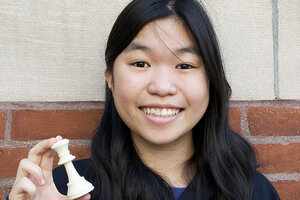Meet America’s top-ranked female chess player: A teenager

Carissa Yip – seen here outside a chess club in Somerville, Massachusetts, on Aug. 10, 2019 – is already a top-ranked chess player. She’s one of a growing number of girls and women who are succeeding in the traditionally male-dominated world of chess tournaments.
Noah Robertson/The Christian Science Monitor
Boston
Just days before her 11th birthday, Carissa Yip became the youngest female chess player to defeat a grandmaster. Pushing her opponent, Alexander Ivanov, to the back of the board, Carissa pounced on a crucial knight and pinned his queen. A few moves later and the match was over.
“I was feeling really proud of myself for that,” says Carissa, who turns 16 on Sept. 10. “Because when I was younger, I was like, ‘Dang, grandmasters are so good,’ and then I beat one.”
Carissa learned the game from her father, Percy, at the age of 6. She’s now one rank away from grandmaster; last year, she won the girls’ division in the United States Junior Championships. According to the International Chess Federation, she is ranked first among women players in America. Her success – so great and so quick – is remarkable.
Why We Wrote This
Percy Yip thought that chess was just for boys – until he saw how well his daughter played. His subsequent push to shift perceptions of the game is emblematic of changes the sport is undergoing, as women rise in the ranks.
But decades ago, it would have been almost unthinkable – not because Carissa is just a high school junior, but because she is a girl. Until recently there were so few female chess players in tournaments that many questioned whether women could ever be as good as men.
“Why couldn’t a girl be just as good in chess as a boy?” says Susan Polgár, a former top-tier player and women’s chess pioneer. “While it sounds obvious perhaps to most people today, it certainly was not then.”
Twenty years ago, fewer than 1% of U.S. Chess Federation players were women, according to Ms. Polgár. Now that number is almost 14%. Jennifer Shahade, former champion player and program director for the USCF’s Women in Chess initiative, says the 13,000 girls and women currently competing in the USCF is the highest number ever.
Large obstacles remain in the way of equal pay and participation, and a fifty-fifty gender ratio may still be far off, Ms. Shahade says. But the numbers are clear: Women are on the rise in chess competitions.
Organizations like the USCF encourage girls to participate through tournaments that network female players at a young age. Having women succeed at the sport’s highest levels makes it easier for more to follow. In 1991, Ms. Polgár was one of the first women grandmasters. Today, more than three dozen women hold the title.
In addition, a larger share of female players boosts the overall quality of women’s chess, Ms. Polgár says. This was also the chief finding from a 2008 study published by the Proceedings of the Royal Society B journal in London. It found that the perceived difference in performance between men and women chess players was a matter of statistics, not a biologically determined skill. The higher number of male players makes it more likely that men will disproportionately rank in the sport’s Top 100 list.
Debunking misogynist theories that men are genetically superior players promotes a more open culture, says Ms. Polgár. The sport’s gender imbalance was so strong that even Mr. Yip was skeptical when his daughter started playing. Wasn’t chess just for boys? Carissa’s success quickly changed his perceptions. Now he’s pushing for a similar shift in others’.
“The reason that it didn’t happen in the past [doesn’t] mean that it will not happen in the future,” he says, referring to equal gender representation in the sport.
In a 1989 interview, chess legend Garry Kasparov commented that there were two kinds of chess: “real chess and women’s chess.” In 2002, Mr. Kasparov lost to a woman – Judit Polgár, Susan’s sister. And in 2016, Carissa received instruction from Mr. Kasparov – now a supporter of women in chess – at a three-day camp for top young players in the U.S.
During the summer, Carissa says she spends almost six hours every day studying puzzles and tactics. Most of her games now last more than four hours. Developing the necessary patience has been difficult, especially for someone with a self-described “killer instinct” on the board. But for her, it’s worth it. She wants to be a grandmaster at the very least.
“I can’t imagine my life without chess,” she says. “I can’t imagine my life before chess, too. ... It’s just a huge part of me.”

